It’s not that the article in the Times wasn’t interesting. It was. But the illustration, or more precisely, the way I interpreted the illustration, says a great deal about what is circulating in the not-so-dusty corners of my mind, where I see myself, where I see my children.
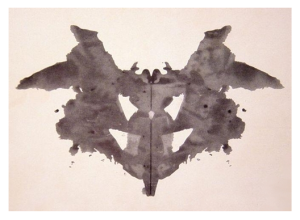 What preoccupies me, at least, at present.
What preoccupies me, at least, at present.
It was like taking an unanticipated Rorschach of sorts, as if someone placed a series of stick figures under my nose and said “you have five minutes to tell us what you see in each of these 20 squares.” And in this variety of images showing both genders engaged in activities – I saw stages of life, I saw myself in the helping role, I felt pleasure at scenes that invoked youth, and I felt sadness at those that struck a chord of loss, isolation, or aging.
State of Mind Influences Everything
Two images in particular elicited a confusing cocktail of emotions.
In one, I thought of my firstborn son, who has just made the transition from college to the corporate world. I experienced that image with notable regret, hoping that he would retain his love of travel and adventure, and somewhat rebellious ability to live life on his own terms.
He has never been a follower. This is a trait that is not unusual in the young, but it is strong and deeply rooted in my son. I have always admired him for it.
My elder child aside, as I turned over the newspaper and read the title of the article below the large illustration, I was surprised. It wasn’t a column on stages of life at all. Nor did it have anything to do with gender, much less roles of agency or accommodation. The article, “A Formula for Happiness,” does indeed offer up mountain climbing and swimming, loving our children and also our pets, getting married and readying for new life, giving (and receiving) a massage, and two images of playing the clown, which both caused me to recoil.
Do We See What We Expect to See?
So much for the formula for happiness, which, according to the article, is more about the importance of “rewarding work” than many would realize – thus the images concerning occupations as much as recreation, with illustrations of our varied pursuits and likelihood to feeling good about our lives.
And the psychology of seeing what we expect to see? My interpretation of riding the dolphin versus the roller coaster, and flipping burgers versus playing soccer?
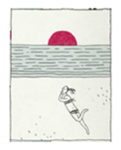 My immediate reactions were as follows: I saw flipping burgers as the college student’s part-time job, and the woman swimming underwater literally left me anxious and feeling trapped, as if I couldn’t surface, despite knowing that land and sun were above. The male student staring at a globe invoked my firstborn, at a time he was still free enough to satisfy his wanderlust. The scene of a corporate presentation (with bobble heads in attendance in a row) elicited worry for that same son, lest he find himself caught for years in a life he may not want.
My immediate reactions were as follows: I saw flipping burgers as the college student’s part-time job, and the woman swimming underwater literally left me anxious and feeling trapped, as if I couldn’t surface, despite knowing that land and sun were above. The male student staring at a globe invoked my firstborn, at a time he was still free enough to satisfy his wanderlust. The scene of a corporate presentation (with bobble heads in attendance in a row) elicited worry for that same son, lest he find himself caught for years in a life he may not want.
Do we see what we expect to see – or do we see what we fear – or both?
Our Personal Rorschach Tests
I confess I’m more curious about my own psychological state in this instance than I am the content of the article. Beyond that, I’m also intrigued by the ways in which we see what we want to see – or what we don’t. We perceive “truths” and situations in light of whatever is currently milling around in our heads – from worries to wants, and fears to fantasies.
And how does this equate to “real life?”
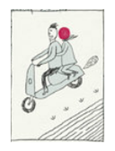 Might we see a cheating partner where he may not exist, because we’re worried about past partners and infidelity?
Might we see a cheating partner where he may not exist, because we’re worried about past partners and infidelity?
Do we imagine others harshly judging our appearance or our actions, because we’ve so internalized the critical voice?
Are our mirrors, our personal Rorschach tests, more available than we think – if we choose to gaze and then consider?
There are some who say we see in others what we fear in ourselves, or perhaps what we fear, period. I’ve also heard that we see what we expect to see – something I’ve personally experienced. Thus, the trusting individual sees people worthy of her trust; the distrustful person is more likely to expect others to earn her trust, and then still to disbelieve it.
On My Mind, On the Agenda
Does it follow then that the individual with gender roles and life stages on her mind – yes, that would be me – will see precisely that in a somewhat ambiguous series of pictures showing people at work and play – both alone and in groups?
I found an interesting column on Psychology Today that discusses the topic of seeing what we expect to see, but it focuses on elements of bias – gender, ethnicity, and we could easily apply this to age as well. It doesn’t explicitly deal with situations or activities, much less the emotional state that may be triggered as a result.
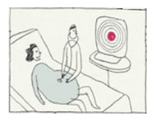 While the 20-some cartoon scenes of people engaged in activity do not comprise a Rorschach test, which does have as its intent to “examine a person’s personality characteristics and emotional functioning,” my response to these images surprises me.
While the 20-some cartoon scenes of people engaged in activity do not comprise a Rorschach test, which does have as its intent to “examine a person’s personality characteristics and emotional functioning,” my response to these images surprises me.
Happiness was the farthest thing from my mind as I looked at them. I’ve been thinking a good deal about my children and their life stages at the moment; I’ve been thinking a good deal about a friend’s elderly mother, going through yet another transition; I’ve been contemplating how many more “reinventions” or shifts I, myself, might be able to undertake.
How many more I might be willing to even entertain.
Do We Ever See Ourselves or Our Lives Clearly?
I see the couple on the motor bike and recall myself at age 15 in France. I see the pregnant woman smiling at a suggested sonogram, and I know that will never again be me. I see the image in which one woman is giving another a spa treatment, hot stones lining the reclining figure’s back. I see myself as the worker, rather than the client on the receiving end.
I see the dog chasing the ball and want to weep for our family mutt, now gone and much missed.
I see a man on bended knee proposing to a woman, and the feelings are so complex – proposals I didn’t accept and the one I did; marriage, divorce, enmity and the shredded beliefs that remain; a vague sorrow that I cannot deny, sensing myself past romantic idealism – the predominant experience is one of loss.
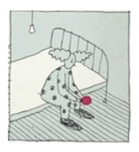 I see the costumed clown who sits on the edge of his bed, desolate – or so I perceive him – quiet after his performance is over, having removed his bright red rubber nose.
I see the costumed clown who sits on the edge of his bed, desolate – or so I perceive him – quiet after his performance is over, having removed his bright red rubber nose.
I wonder if we ever see clearly, or how it is we arrive at seeing more clearly. I wonder if it isn’t helpful to spend time with our ink blots whatever their origins – those that reflect our preoccupations, so we can adjust our mirrors and perhaps, our perceptions.
And surely those perceptions are fundamental to happiness.
Image of Rorschach Ink blot 01, U.S. Public Domain, explanation here.
Thumbnail images created from Times illustration by Brian Rea.
Do check out the Times article. It’s certainly worthy of a discussion on its own.
You May Also Enjoy
I always, always see the same thing in that 01 blot–I always see an xray of a woman’s pelvis. Go figure.
Ha! Good one, Carol.
We perceive “truths” and situations in light of whatever is currently milling around in our heads – from worries to wants, and fears to fantasies. Would you please get out of my head!! 🙂 I’m having this exact issue as I look at my two children and where they are (and are not) in life these days. This post is truly amazing. I believe it’s one of your best…if that’s even possible to pick between so many great ones.